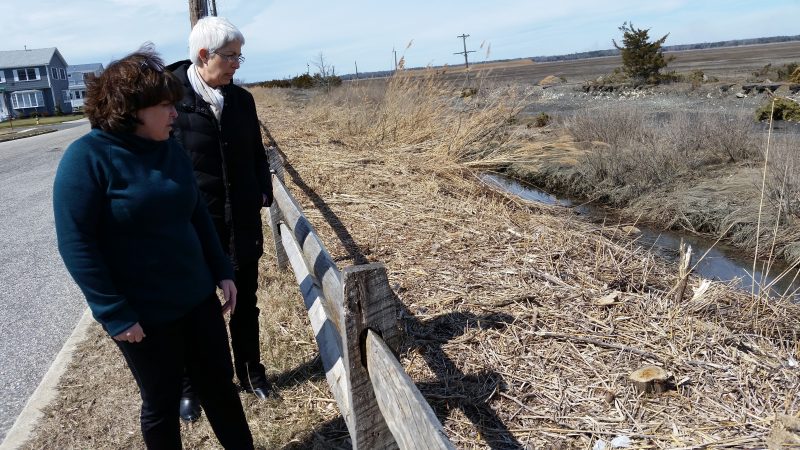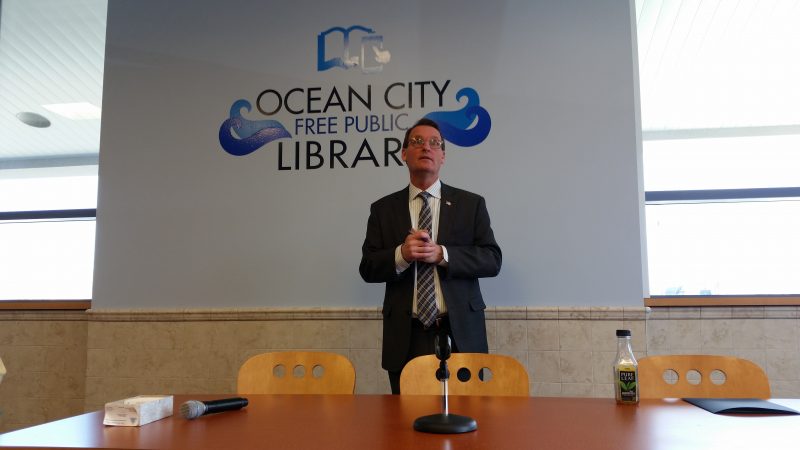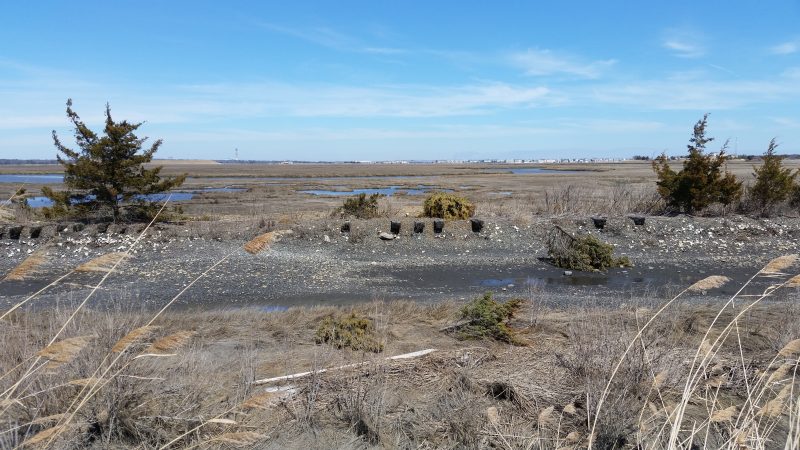The mayor believes that flooding around 52nd Street is caused by an old, deteriorated railroad embankment, seen in background.
 By Donald Wittkowski
Many of the cedar, cherry and pear trees that had lined a split-rail fence on property overlooking the marshlands along 52nd Street in Ocean City are now gone. Their stumps are all that remain.
“To be honest with you, I was stunned when I counted 42,” Carolyn Logan, a resident of Bark Drive, just off 52nd Street, exclaimed of the number of stumps.
Logan estimated some of the trees were 15 to 20 feet tall. But they weren’t the only things that were chopped down. Phragmites, bayberry bushes and other native plants that were part of what Logan and her neighbor, Margaret McGonigle, of Anchorage Drive, described as an environmentally sensitive area have disappeared, too.
“Before they cut everything down, you could not see through here at all. This was lush,” McGonigle recalled of the thicket of trees, bushes and marsh reeds. “But now, I can see all the way to Super Liquors.”
The Super Liquors store she referred to is some three miles across the expanse of marshlands in the neighboring town of Marmora.
In late December, a contractor hired by Ocean City cut down trees and vegetation along a nearly half-mile stretch of 52nd Street as part of a maintenance program to keep the tall growth in check, but in doing so, has drawn the anger of some of the neighbors.
By Donald Wittkowski
Many of the cedar, cherry and pear trees that had lined a split-rail fence on property overlooking the marshlands along 52nd Street in Ocean City are now gone. Their stumps are all that remain.
“To be honest with you, I was stunned when I counted 42,” Carolyn Logan, a resident of Bark Drive, just off 52nd Street, exclaimed of the number of stumps.
Logan estimated some of the trees were 15 to 20 feet tall. But they weren’t the only things that were chopped down. Phragmites, bayberry bushes and other native plants that were part of what Logan and her neighbor, Margaret McGonigle, of Anchorage Drive, described as an environmentally sensitive area have disappeared, too.
“Before they cut everything down, you could not see through here at all. This was lush,” McGonigle recalled of the thicket of trees, bushes and marsh reeds. “But now, I can see all the way to Super Liquors.”
The Super Liquors store she referred to is some three miles across the expanse of marshlands in the neighboring town of Marmora.
In late December, a contractor hired by Ocean City cut down trees and vegetation along a nearly half-mile stretch of 52nd Street as part of a maintenance program to keep the tall growth in check, but in doing so, has drawn the anger of some of the neighbors.
 Trees, bushes and marsh reeds along the fence line on 52nd Street have been chopped down.
Logan and McGonigle complained about the tree cutting to Mayor Jay Gillian during a meeting Saturday organized by Councilman Bob Barr for residents of the Fourth Ward. Gillian expressed his regrets for what he said appeared to be an “overzealous” cuttingoperation by the city contractor.
“I apologize for that. I own that one,” Gillian told the audience of about 60 residents who attended the meeting at the Ocean City Free Public Library.
Most of the meeting focused on a $6.5 million drainage and road project that will help reduce flooding in the Fourth Ward between 28th and 34th streets. But Logan and McGonigle pressed the mayor for answers about the tree-cutting operation when he opened the floor for questions.
Gillian said the maintenance project has split the neighborhood “50-50,” noting that half of the residents objected to the loss of so many trees and bushes, while the other half enjoyed getting back their unfettered view of the marshlands.
At the same time, Gillian promised to come back to the Fourth Ward residents with a plan for future cutting operations, as well as a strategy to protect the neighborhoods surrounding 52nd Street from floodwaters that come from the marshlands.
“That’s on the front burner,” he said.
Echoing Gillian’s comments, Barr, who represents the Fourth Ward on City Council, told the residents that the project will remain on “the front page.”
Trees, bushes and marsh reeds along the fence line on 52nd Street have been chopped down.
Logan and McGonigle complained about the tree cutting to Mayor Jay Gillian during a meeting Saturday organized by Councilman Bob Barr for residents of the Fourth Ward. Gillian expressed his regrets for what he said appeared to be an “overzealous” cuttingoperation by the city contractor.
“I apologize for that. I own that one,” Gillian told the audience of about 60 residents who attended the meeting at the Ocean City Free Public Library.
Most of the meeting focused on a $6.5 million drainage and road project that will help reduce flooding in the Fourth Ward between 28th and 34th streets. But Logan and McGonigle pressed the mayor for answers about the tree-cutting operation when he opened the floor for questions.
Gillian said the maintenance project has split the neighborhood “50-50,” noting that half of the residents objected to the loss of so many trees and bushes, while the other half enjoyed getting back their unfettered view of the marshlands.
At the same time, Gillian promised to come back to the Fourth Ward residents with a plan for future cutting operations, as well as a strategy to protect the neighborhoods surrounding 52nd Street from floodwaters that come from the marshlands.
“That’s on the front burner,” he said.
Echoing Gillian’s comments, Barr, who represents the Fourth Ward on City Council, told the residents that the project will remain on “the front page.” Mayor Jay Gillian promised residents of the Fourth Ward that he is looking into the tree cutting.
Logan and McGonigle grumbled that the cutting of so much vegetation has left the area looking barren and stark, depriving the wildlife of valuable shelter and food in the process.
“It’s a refuge for butterflies, migrating birds and turtles. It once was a beautiful area. It had been undisturbed before they did this,” Logan said, gazing at the denuded landscape.
McGonigle said on the first day of cutting in December, the contractor trimmed just a little bit of the vegetation. She was stunned by what happened on the second day.
“Then they came back the next day and it was all gone,” she said. “They came back and cut many, many more feet along the fence line.”
During a City Council meeting in January, when residents first complained to city officials about the cutting operation, City Business Administrator Jim Mallon explained that the area was becoming overgrown with phragmites, poison ivy and poison sumac.
“The objective of this brush removal will provide improved and clearer access to a historically grassy area,” Mallon said during the Council meeting. “The path near the split-rail fence is commonly used by neighborhood pet owners to walk their animals, and nearby homeowners appreciate the city keeping the area maintained.”
Besides complaining about the altered aesthetics, Logan and McGonigle expressed fear that the loss of so many trees and bushes has removed a natural barrier protecting the neighborhoods from the wind-blown flooding that comes from the marshlands.
“That was a block, at least, that gave us some flood protection,” McGonigle said.
During Saturday’s meeting with Fourth Ward residents, Gillian said he believes the flooding is mainly caused by a deteriorated dirt embankment that was once part of the track for a railroad that served Ocean City years ago. Still visible on top of the embankment are the remnants of old wooden railroad ties that carried the track over the marshlands.
Mayor Jay Gillian promised residents of the Fourth Ward that he is looking into the tree cutting.
Logan and McGonigle grumbled that the cutting of so much vegetation has left the area looking barren and stark, depriving the wildlife of valuable shelter and food in the process.
“It’s a refuge for butterflies, migrating birds and turtles. It once was a beautiful area. It had been undisturbed before they did this,” Logan said, gazing at the denuded landscape.
McGonigle said on the first day of cutting in December, the contractor trimmed just a little bit of the vegetation. She was stunned by what happened on the second day.
“Then they came back the next day and it was all gone,” she said. “They came back and cut many, many more feet along the fence line.”
During a City Council meeting in January, when residents first complained to city officials about the cutting operation, City Business Administrator Jim Mallon explained that the area was becoming overgrown with phragmites, poison ivy and poison sumac.
“The objective of this brush removal will provide improved and clearer access to a historically grassy area,” Mallon said during the Council meeting. “The path near the split-rail fence is commonly used by neighborhood pet owners to walk their animals, and nearby homeowners appreciate the city keeping the area maintained.”
Besides complaining about the altered aesthetics, Logan and McGonigle expressed fear that the loss of so many trees and bushes has removed a natural barrier protecting the neighborhoods from the wind-blown flooding that comes from the marshlands.
“That was a block, at least, that gave us some flood protection,” McGonigle said.
During Saturday’s meeting with Fourth Ward residents, Gillian said he believes the flooding is mainly caused by a deteriorated dirt embankment that was once part of the track for a railroad that served Ocean City years ago. Still visible on top of the embankment are the remnants of old wooden railroad ties that carried the track over the marshlands.
 The mayor believes that flooding from the marshlands around 52nd Street is caused by an old, deteriorated railroad embankment, seen in background.
An engineering consultant for the city is in discussions with the New Jersey Department of Environmental Protection on a flood-prevention plan. Gillian said he would share the plan with the Fourth Ward residents when it is ready.
In an interview, Logan said she appreciates that the mayor has pledged to look into the matter and consult with residents.
But in the meantime, Logan and McGonigle are not pleased with the newly created, wide-open view of the marshlands – without the trees, bushes and tall reeds that were once there.
“If I had binoculars, I could count the number of cars in the parking lot at Super Liquors,” Logan said ruefully.
The mayor believes that flooding from the marshlands around 52nd Street is caused by an old, deteriorated railroad embankment, seen in background.
An engineering consultant for the city is in discussions with the New Jersey Department of Environmental Protection on a flood-prevention plan. Gillian said he would share the plan with the Fourth Ward residents when it is ready.
In an interview, Logan said she appreciates that the mayor has pledged to look into the matter and consult with residents.
But in the meantime, Logan and McGonigle are not pleased with the newly created, wide-open view of the marshlands – without the trees, bushes and tall reeds that were once there.
“If I had binoculars, I could count the number of cars in the parking lot at Super Liquors,” Logan said ruefully.